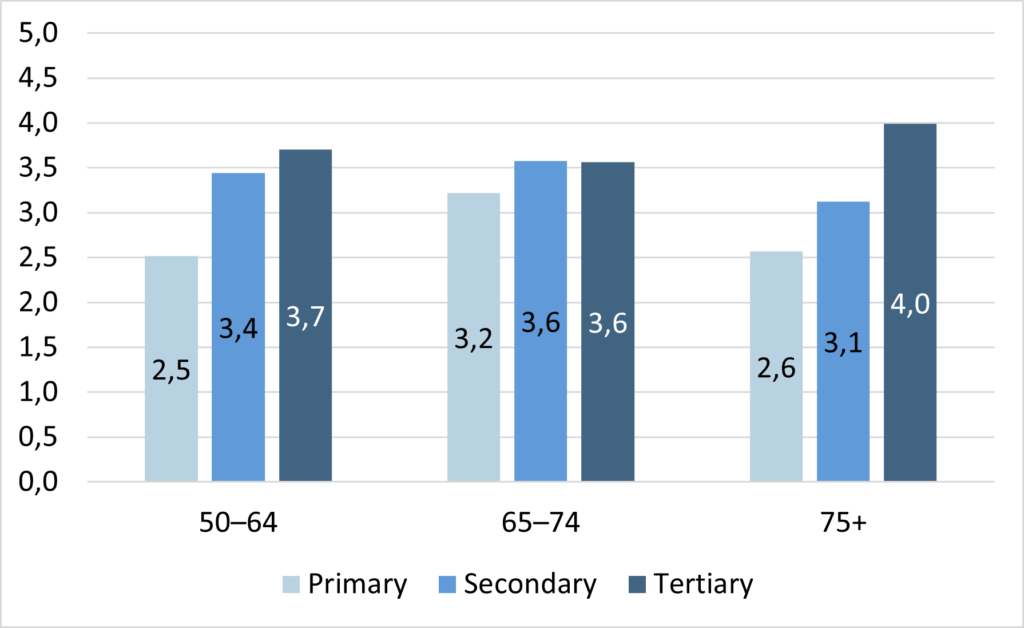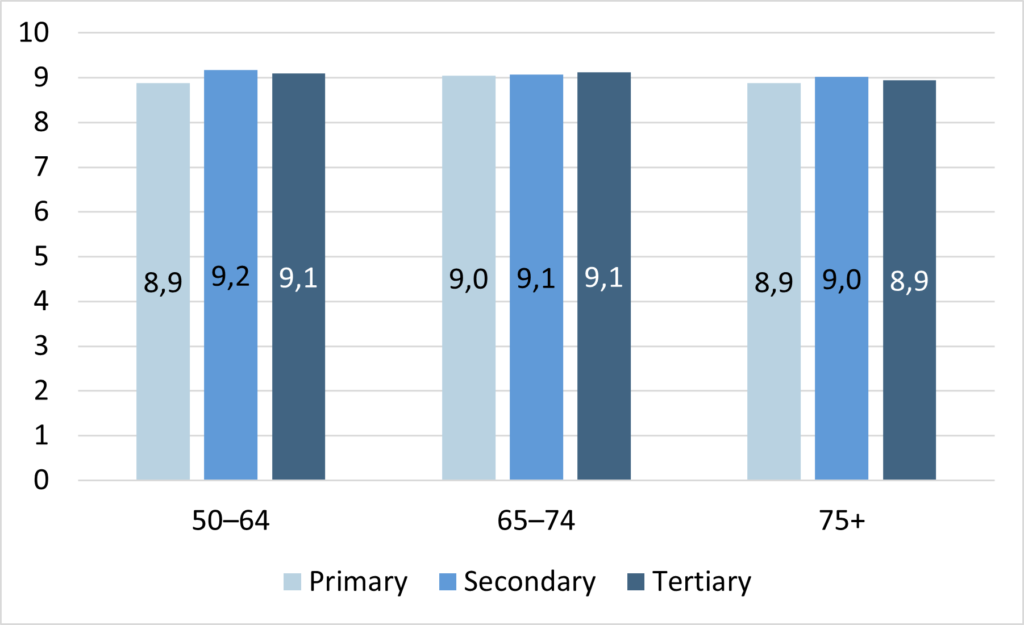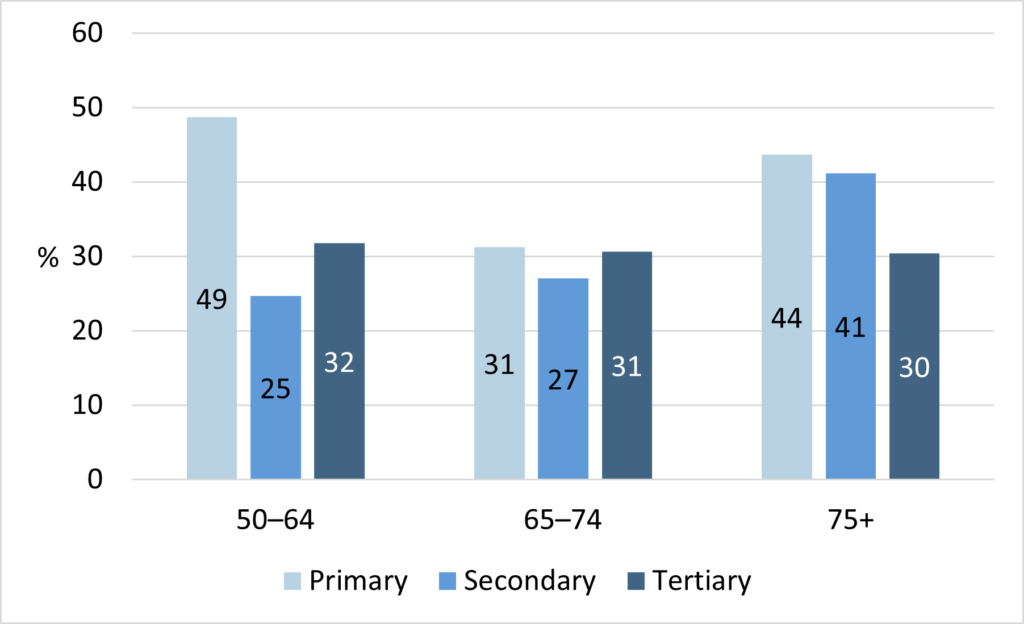Differences in close relationships and loneliness among ageing Finns are seen across educational groups

Finns aged 50+ are highly satisfied with their social relationships. But do all ageing Finns fare equally well, or are there socioeconomic differences in close relationships? This Science Leak article examines how the social relationships and experiences of loneliness among Finns aged 50 and over vary by educational background.
The Finnish country report based on the data from the ninth wave of the Survey of Health, Ageing and Retirement in Europe (SHARE) shows that, on a scale from zero to ten, ageing Finns rate their satisfaction with close relationships at an average of 9.1 (Auero & Lahtela, 2024). This figure is among the highest in Europe, and furthermore, Finns have one of the largest social networks in Europe (Rotkirch & Abulazde, 2022).
In the SHARE survey, close social networks are mapped out by asking the respondents to name up to seven people with whom they most frequently discuss matters important to them. Additionally, respondents are asked about the nature of their relationship with each mentioned person (e.g., spouse, friend, child), how close they feel to them, how satisfied they are with these relationships, and how close these individuals live to them.
Finns aged 50 and over have on average 3.4 close relationships. There is a clear gender difference in the number of close connections: women mention an average of 3.7 close relationships, while for men, the number is 3.0. When examining the data by education level, it is evident that those with higher education have more close relationships in all age groups compared to those with lower education (Figure 1). The largest difference by education level is found in the 75+ age group, where individuals with only primary education have an average of 2.6 close relationships, whereas those with tertiary education have an average of four close relationships.
Figure 1. The average number of close people (0–7) mentioned in the SHARE interview, by age group and education level

Highly educated individuals have more friends among their close relationships
The difference in the number of friends by education level is most pronounced in the 50–64 age group, where highly educated individuals include an average of 1.2 friends among their close connections, those with secondary education have an average of 1.0, and those with lower education have 0.5. Women have more friends among their close relationships than men: among those aged 50 and over, women have an average of 1.1 friends, while the average for men is 0.7.
There are hardly any differences in the number of children included among close relationships across education levels. Both those with primary education and those with secondary education have an average of 1.0 children among their mentioned close connections, while highly educated individuals have an average of 0.9.
The number of very close or extremely close social relationships varies across education levels. Highly educated individuals have an average of 2.9 such relationships, while those with lower education have 2.1. Additionally, a gender difference is evident once again: women have an average of 2.8 very or extremely close relationships, whereas men have 2.2.
Differences between education levels are also observed in how close members of one’s social network live. A larger proportion of highly educated individuals live with a spouse compared to those with lower education, meaning that their closest person is more often someone living in the same household. This difference is most pronounced in the under 65 age group, where 64% of highly educated individuals have their closest person living in the same household or building, compared to 43% of those with primary education. Among those aged 75 and over, 21% of individuals with lower education have their closest person living more than five kilometres away, whereas for highly educated individuals, this share is only 7%.
Satisfaction with close relationships is assessed on a scale from 0 to 10, where 0 means completely dissatisfied and 10 means completely satisfied. Those with secondary and tertiary education are slightly more satisfied with their close relationships than those with primary education, but the differences are small, and satisfaction remains high across all education and age groups (Figure 2). Women, with an average satisfaction score of 9.2, are slightly more satisfied with their close relationships than men, whose average score is 8.9.
Figure 2. Average satisfaction with close relationships mentioned in the interview on a scale from 0 to 10, by age group and education level

Loneliness is most common among those with lower education
Although satisfaction with close relationships is high across all education levels, feelings of loneliness are still most common among those with lower education. Among people aged 50–64 with only basic education, nearly half (49%) report feeling lonely sometimes or often, whereas the lowest share is found among those with secondary education, at 25% (Figure 3).
Among people aged 65–74, differences in loneliness by education level are small, but among those aged 75 and over, the disparities are more pronounced: 44% of individuals with lower education report experiencing loneliness, compared to 30% of highly educated individuals. There are no significant gender differences in loneliness among those aged 50–74, but among those aged 75 and over, loneliness is clearly more common among women than men (47% vs. 32%).
Figure 3. Proportion of individuals experiencing loneliness sometimes or often, by age group and education level

The 50+ in Finland report identifies educational differences in several aspects of well-being and living conditions. Social relationships and loneliness are no exception – those with only primary education have fewer close relationships and are more likely to experience loneliness than others. Despite this, satisfaction with existing close relationships remains high among ageing Finns, regardless of education level, and approximately 98% of Finns aged 50 and over have at least one close person in their lives with whom they can discuss important matters and concerns.
More information
Kristel Auero, researcher
kristel.auero@vaestoliitto.fi
References
Auero, K. & Lahtela, J. (2024). 50+ Suomessa – Tuloksia Survey of Health, Ageing and Retirement in Europe (SHARE) -tutkimuksen 9. aallosta. [50+ in Finland – Results from the 9th wave of the Survey of Health, Ageing and Retirement in Europe (SHARE)] Väestöliitto, Population Research Institute.
Rotkirch, A. & Abulazde, L. (2022). Suomalaisilla on Euroopan laajimmat sosiaaliset verkostot. [Finns have the largest social networks in Europe] Science leak article 5/2022. Helsinki: Väestöliitto, Population Reseach Institute.
SHARE-ERIC (2024). Survey of Health, Ageing and Retirement in Europe (SHARE) Wave 9. Release version: 9.0.0. SHARE-ERIC. Data set. DOI: 10.6103/SHARE.w9.900.
How to cite
Auero, K. (2025). Differences in close relationships and loneliness among ageing Finns are seen across educational groups. Science Leak article 4/2025. Helsinki: Väestöliitto, Population Research Insitute. Available: https://www.vaestoliitto.fi/en/articles/differences-in-close-relationships-and-loneliness-among-ageing-finns-are-seen-across-educational-groups/ [Viitattu: ##.##.20##].
The research is part of the The Social networks, fertility and wellbeing in ageing populations: Building demographic resilience in Finland (NetResilience) project, which involves Väestöliitto, University of Turku, University of Helsinki and Aalto University. The research has received funding from the Strategic Research Council within the Academy of Finland.
